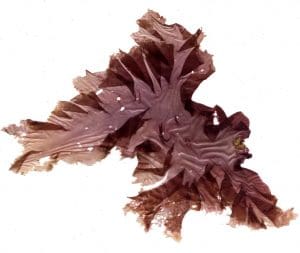Nori / Spring / Summer / Autumn / Winter / Edible

Other Common Names:
sometimes called Laver (not strictly correct, but they are very similar)
Latin Name:
Pyropia yezoensis, californica, tenera and other species. Note that Laver is in the Porphyria genus, but the seaweeds in each are often reclassified.
Physical Characteristics:
A red seaweed that has thin, membranous, folded blades that can appear red, brown, pinkish or even dark green.

Habitat, Range and Distribution:
A seaweed that likes the intertidal zones. It tends to grow in patches and will hold fast to the sea floor but particularly likes rocks. It is found globally in warm-temperate waters. You are more likely to find Laver than Nori in Britain, but they can be used identically.
Conservation Considerations:
This is a seaweed that has been studied due to its resilience in the face of environmental stressors such as desiccation, temperature fluctuation and other features of changing environments. Several Pyropia species are extensively farmed in east Asia to provide Nori for the food industry.
Harvest Time and Techniques:
Aim to harvest when the tide is low to give you plenty of time to take in the seaside. Always cut the tips of the alga you harvest away with a sharp blade, leaving the holdfast to regenerate. Check the legality of harvesting in places that are conserved.
Could Be Confused With:
Nori is incredibly similar to Laver and can be used in the same way safely.
Edible Uses:
Both Laver and Nori are delicious! If you dry them first, they can be easily stored and rehydrated when you are ready to use them. Add squares to soups and stews, or rehydrate full sheets to use in sushi making. You could also crumble dried nori into your salt, fold it into your butter, add to breads and crackers, or even infuse some into a foraged alcohol or freeze it into your cocktail ice cubes for an umami twist.
Medicinal Uses:
Nori, like all seaweeds, are very high in iodine, making moderate regular consumption a great way to keep essential minerals high.
Extras:
Make a point of checking the water quality status before you harvest seaweed for consumption.






Leave a Reply
You must be logged in to post a comment.